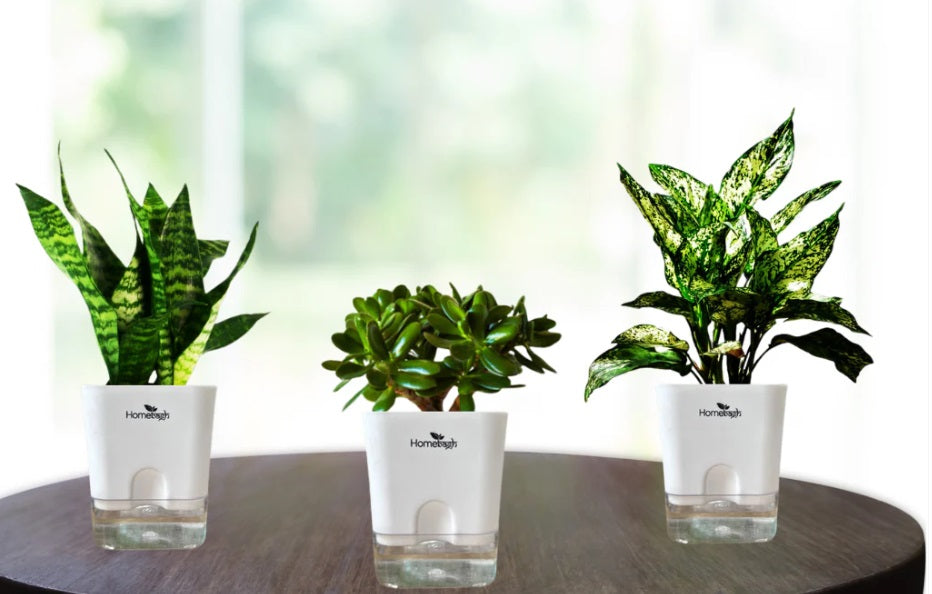Plants indoors do more than just make a place look nicer; they also help make it healthier and more serene. One of the best things about indoor plants is that they may clean the air and make you feel better overall. Air pollution is becoming more of a problem, especially in cities like India, where the air inside can often be worse than the air outside. Adding plants that clean the air to your home is a natural and practical way to solve this problem. In this post, we'll talk about how important indoor plants are for cleaning the air, list some of the best plants for making the air inside your home better, give you some basic maintenance recommendations, and set the record straight on some common misconceptions about indoor plants.
Benefits of Air Purifying Indoor Plants
Indoor plants provide numerous benefits that go beyond decoration. One of the most compelling reasons to have plants indoors is their ability to purify the air. According to NASA’s Clean Air Study, certain indoor plants are capable of removing harmful toxins from the air, such as formaldehyde, benzene, xylene, and trichloroethylene. These toxins are commonly found in household products like paints, cleaning agents, and furniture. By absorbing these pollutants, plants not only make your air cleaner but also contribute to a healthier living environment.
Indoor plants not only make the air cleaner, but they also assist control humidity. Plants send water out of their leaves into the air through a process called transpiration. This helps keep the humidity levels in your home stable. This is really crucial in places with dry climates or air conditioning, because dry air can make you uncomfortable and hurt your breathing. Studies have also shown that keeping plants inside can lower stress, improve mood, and make you more productive, which makes them a terrific addition to any home.
Here are some specific benefits of air-purifying indoor plants:
-
Reduction of indoor air pollutants: Plants absorb harmful chemicals and pollutants like formaldehyde, benzene, and carbon monoxide.
-
Enhanced humidity levels: Plants release moisture into the air, helping prevent dry skin, dry eyes, and respiratory issues.
-
Improved mood and mental well-being: The presence of plants can reduce stress and anxiety levels, promoting relaxation and focus.
-
Increased oxygen levels: Plants produce oxygen through photosynthesis, helping to increase the oxygen content of the air, making the environment more refreshing.
-
Noise reduction: Plants can absorb and deflect sound, contributing to a quieter and more peaceful indoor environment.
Best Indoor Plants for Air Purification
Now that we know the benefits, let's look more closely at the best indoor plants that are known to clean the air. These plants are simple to care for and great for both new and seasoned plant owners. These plants can help clean the air and bring nature inside, whether you live in an apartment in the city or a house in the suburbs.
Top 10 Air Purifying Indoor Plants
-
Spider Plant (Chlorophytum comosum)
-
Air-purifying qualities: Known for removing formaldehyde and xylene, common pollutants found in household products.
-
Care: Low maintenance and adaptable to various light conditions. Water it when the soil feels dry.
-
Snake Plant (Sansevieria trifasciata)
-
Air-purifying qualities: Efficient at filtering out formaldehyde, benzene, and other harmful chemicals. It also converts CO2 into oxygen at night, unlike most plants.
-
Care: Very hardy and can thrive in low light. Water when the soil is dry, as it is drought-tolerant.
-
Peace Lily (Spathiphyllum)
-
Air-purifying qualities: Removes a range of toxins, including formaldehyde, benzene, and trichloroethylene.
-
Care: Requires moderate indirect light and consistent watering. Keep the soil moist but not waterlogged.
-
Areca Palm (Dypsis lutescens)
-
Air-purifying qualities: Helps remove formaldehyde and xylene while adding moisture to the air.
-
Care: Prefers bright, indirect light and regular watering to keep the soil moist.
-
Aloe Vera
-
Air-purifying qualities: Filters out formaldehyde and benzene and is also well-known for its medicinal properties.
-
Care: Requires plenty of sunlight and minimal watering. Aloe vera thrives in dry conditions and well-drained soil.
-
Bamboo Palm (Chamaedorea seifrizii)
-
Air-purifying qualities: Known for removing formaldehyde, benzene, and trichloroethylene.
-
Care: Prefers indirect light and regular watering. It thrives in humid conditions, making it ideal for bathrooms.
-
English Ivy (Hedera helix)
-
Air-purifying qualities: Effective at removing formaldehyde, benzene, and trichloroethylene from the air.
-
Care: Requires moderate sunlight and well-drained soil. Water it regularly but avoid over-watering.
-
Golden Pothos (Epipremnum aureum)
-
Air-purifying qualities: Removes formaldehyde, benzene, and xylene.
-
Care: Tolerates low light conditions and is low maintenance. Water it when the soil is dry.
-
Philodendron
-
Air-purifying qualities: Absorbs formaldehyde, benzene, and trichloroethylene.
-
Care: Thrives in low to moderate light and requires watering when the top layer of soil feels dry.
-
-
Dracaena
-
Air-purifying qualities: Removes formaldehyde, benzene, trichloroethylene, and xylene from the air.
-
Care: Prefers indirect light and needs to be watered when the soil is dry.
Care Tips for Indoor Plants
To keep your indoor plants healthy and able to clean the air, you need to take care of them. To keep your plants healthy, here are some important care tips:
-
Light: Most air purifying plants thrive in indirect light. Avoid placing them in direct sunlight for long periods as this can cause the leaves to burn. Ensure your plants get enough light based on their individual needs.
-
Watering: Overwatering is one of the most common mistakes when caring for indoor plants. Water your plants only when the soil is dry to avoid root rot. Be sure to empty any excess water in the saucer to prevent stagnation.
-
Humidity: Many indoor plants, like ferns and palms, prefer higher humidity levels. To improve humidity, mist the leaves occasionally or place a humidity tray near the plants.
-
Fertilization: Use a balanced, water-soluble fertilizer every 4-6 weeks during the growing season (spring and summer). Be sure not to over-fertilize, as this can harm the plant.
-
Cleaning: Dust can block the leaves of your plants from absorbing sunlight and reduce their ability to purify the air. Wipe the leaves regularly with a damp cloth to keep them clean.
Common Myths about Indoor Plants
Indoor plants are great for making your home a better place to live, but some people may not want to bring them inside because they believe some false information. Let's talk about some prevalent myths:
1. Indoor Plants are Difficult to Care For
-
Fact: Many indoor plants are low maintenance and require minimal care. Plants like the snake plant, pothos, and spider plant are easy to look after and suitable for beginners.
2. Indoor Plants Make the Air Too Humid
-
Fact: While some plants release moisture into the air, they are unlikely to raise the humidity to unhealthy levels, especially in well-ventilated homes. In fact, higher humidity can be beneficial in dry climates.
3. All Plants Purify the Air the Same Way
-
Fact: Not all indoor plants purify the air equally. Certain plants, like the peace lily and snake plant, are particularly effective at removing toxins from the air.
4. Plants Are Not Safe for Pets
-
Fact: While some indoor plants can be toxic to pets (e.g., lilies), many air-purifying plants are safe for pets. If you have pets, make sure to research the plant species before bringing them indoors.
Conclusion
Plants inside your home are more than just pretty decorations; they also help make the air cleaner and the environment healthier. There is a plant for every home and lifestyle because there are so many that clean the air. You may make your home cleaner, fresher, and more colorful by adding plants like the snake plant, peace flower, and bamboo palm. Also, taking care of these plants is easy and pleasant, and it will be good for your health and the way they look in the long term.
Indoor plants are a natural way to cope with pollution in the environment. They not only improve the air we breathe, but they also provide the relaxing presence of nature inside.
FAQ Section
1. How do indoor plants purify air?
Photosynthesis is the mechanism by which indoor plants clean the air by taking in carbon dioxide and giving off oxygen. Plants can also assist clean the air by taking in dangerous chemicals like formaldehyde, benzene, and trichloroethylene through their leaves and roots.
2. Which indoor plants are safe for pets?
Some houseplants are healthy for pets, while others might be harmful. Spider plants, Boston ferns, and bamboo palms are all safe for pets. But before you bring a plant into your home, be sure it's safe for your pet.
3. How often should I water my indoor plants?
It depends on the type of plant how often you should water it. A good rule of thumb is to water when the top inch of soil feels dry. Don't water too much, because it can cause root rot. Always check what each plant needs.

